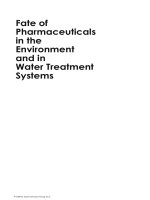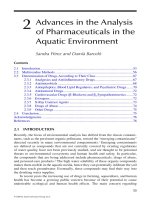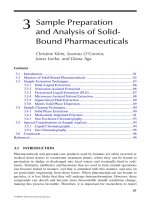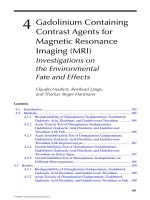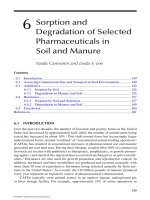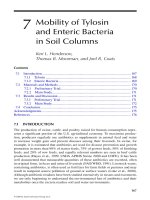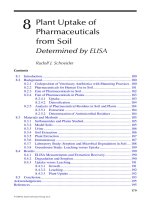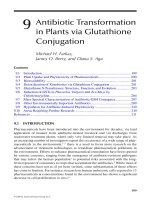Fate of Pharmaceuticals in the Environment and in Water Treatment Systems - Chapter 9 docx
Bạn đang xem bản rút gọn của tài liệu. Xem và tải ngay bản đầy đủ của tài liệu tại đây (209.23 KB, 15 trang )
199
9
Antib iotic Transformation
in Plants via Glutathione
Conjugation
Michael H. Farkas,
James O. Berry, and Diana S. Aga
9.1 INTRODUCTION
Pharmaceuticals have been introduced into the environment for decades, via land
application of manure from antibiotic-treated livestock and via discharges from
wastewater treatment plants, where only very limited removal may take place. As
an increasing number of investigators report the occurrence of a wide range of phar-
maceuticals in the environment,
1–3
thereisaneedtofocusmoreresearchonthe
advancement of treatment technologies to remediate pharmaceutical pollutants in
the environment. Efforts to enhance pharmaceutical remediation have been spurred
by various concerns, ranging from the emergence of antibiotic-resistant pathogens
that may infect the human population
4
to potential risks associated with the long-
termexposureofconsumerstocropsthataccumulatetheantibiotics.
5
While most of
these concerns have not as of yet been veried, some substantiation of these effects
has come to fruition. For instance, research on human embryonic cells exposed to 13
pharmaceuticals at concentrations found in the environment has shown a signicant
decrease in cell proliferation in vitro.
6
Contents
9.1 Introduction 199
9.2 Plant Uptake and Phytotoxicity of Pharmaceuticals 200
9.3 Bioavailability 201
9.4 Detoxication of Xenobiotics via Glutathione Conjugation 201
9.5 Glutathione S-Transferases: Structure, Function, and Evolution 203
9.6 InductionofGSTsin Phaseolus Vulgaris and Zea Mays by
Ch lor tetr acycl ine 2 04
9.7 Mass Spectral Characterization of Antibiotic-GSH Conjugates 207
9.8 Other Environmentally Important Antibiotics 209
9.9 Hypothesis for Antibiotic-Induced Phytotoxicity 210
9.10 A reas Re quir ing Further Research 210
References 211
© 2008 by Taylor & Francis Group, LLC
200 Fate of Pharmaceuticals in the Environment and in Water Treatment Systems
Phytoremediation,theapplicationofplantsandtheirassociatedmicrobesto
enhance biodegradation of contaminants in the environment, has recently been
explored for the remediation of sulfadimethoxine
7
and oxytetracycline
8
antibiotics.
Thephytoremediationofmetalsandorganicpollutantsinsoilisanemerging,low-
cost technology, but the underlying biochemical mechanisms involved in contami
-
na
ntuptake,detoxication,andtranslocationinplantsarelargelyunknown.One
well-known detoxication pathway involves phytotransformation of contaminants
via glutathione (GSH) conjugation, which is catalyzed by glutathione s-transferase
(GST) enzymes. This chapter provides an overview on the role of plant GSTs in phy
-
to
remediationoforganiccontaminantsandpresentsrecentworkonGST-mediated
transformations of environmentally relevant antibiotics.
9.2 PLANT UPTAKE AND PHYTOTOXICITY
OF PHARMACEUTICALS
Like many heavy metals and organic contaminants, antibiotics can be taken up by
plantsandcanelicitphytotoxicityinsusceptiblespecies.Infact,ithasbeenknown
for quite some time that chlortetracycline, a highly used growth-promoting antibi
-
ot
ic,isphytotoxictopintobeans(Phaseolus vulgaris).
9
More recent reports have
demonstrated the phytotoxic effects of sulfadimethoxine antibiotics toward maize
and barley
10
andalsothatofenrooxacinantibioticstoseveralagriculturalcrops.
11
However,someplantspeciesdonotappeartobeaffectedbyexposuretoantibiotics.
For example, in the same study that reported phytotoxicity of chlortetracycline to
pintobeans,itwasshownthat
Zea mays was u
naffected by the antibiotic exposure.
9
Pharmaceutical-induced phytotoxicity does not appear to cause plant mortality
but rather leads to inhibition of plant growth and ultimately lower crop yields. For
example, enrooxacin, a broad-spectrum antibiotic that is used in both human and
veterinarymedicine,inhibitsrootgrowthandleafdevelopmentinavarietyofcrop
plants.
11
Statins, which are cholesterol-reducing agents that are highly prescribed
for human health, can inhibit 3-hydroxyl-3-methylglutaryl coenzyme A reductase
inplants,blockingisoprenoidbiosynthesis,whichisimportantforamultitudeof
endogenousfuncti ons.
12
Direct quantication of the amount of contaminants that accumulate in plant
tissuesisdifcultbecauseoftheanalyticalchallengesassociatedwithdetectinglow
levels of analytes within the complex plant biomass. Recently, however, Kumar and
coworkers
5
were able to measure concentrations of chlortetracycline that accumu-
latedinmaize,cabbage,andgreenonionsatthepartsperbillion(ppb)rangeusing
enzyme-linked immunosorbent assay (ELISA) techniques. Beyond pharmaceuti
-
cal
s,othertoxicorganiccompoundshavebeenshowntoaccumulateinthefruitsof
apple and peach trees.
13
Trichloroethylene, a cleaning and degreasing agent widely
usedforindustrialandmilitarypurposesintheUnitedStates,hasbeenfoundinthe
environmentatlevelsashighas500ppm.Acontrolledgreenhousestudyhasshown
thatwithin2yearsofexposure,appleandpeachtreeswereabletoaccumulateas
much as 34 ppm.
© 2008 by Taylor & Francis Group, LLC
Antibiotic Transformation in Plants via Glutathione Conjugation 201
9.3 BIOAVAILABILITY
The bioavailability of pharmaceuticals is an important factor to consider when
investigatingtheirinteractionswithplants.Generally,thetoxicityofacontaminant
is directly related to its bioavailability.
14
In soil, the bioavailability of an antibiotic
dependsontwomajorfactors:(1)thedegreetowhichitadsorbstothesoiland(2)
theorganismsinhabitingthesoil.Sorptionofantibioticstosoilisdependentonthe
soilcompositionanditschemicalcharacteristics,suchaspHandionicstrength.
Soil composition can vary with regard to its clay, sand, organic matter, and min
-
er
alcontent,allofwhichplayanimportantroleinantibioticsorption.Forinstance,
sulfonamide antibiotics adsorb more strongly to clay than to sand, and in general,
antibiotics adsorb less tightly to soil minerals than to organic matter.
14
However, the
soil’smineralcompositionplaysaroleintetracyclinebinding.ItisknownthatCa
2+
sorption to clay increases oxytetracycline adsorption relative to Na
+
.SoilpHmust
also be factored into antibiotic bioavailability. Sulfonamides and tetracyclines are
adsorbedmoretightlyinthepresenceofacidicsoils,whereastheoppositeistruefor
tylosin (macrolide family of antibiotics).
15
Some antibiotics have hydrophobic char-
acteristicsandcannotdissolveinwaterwithoutadditionalfactors,butitappearsthat
hydrophobicity is not directly related to the strength of sorption of these antibiot-
ic
stosoil.
16,17
In general, electrostatic forces, complexation, and hydrogen bonding,
whichareregulatedbythesoilcontentandchemistry,areallimportantindetermin-
in
g antibiotic bioavailability.
The rhizosphere, the area surrounding a plant’s roots, is very dynamic and full of
microorganismsthatplayaroleinthefateandbioavailabilityofantibioticsandother
contaminants in soil. Root exudates in the rhizosphere may contain reactive oxygen
species (ROS) such as H
2
O
2
,whichareproducedbyplantsasageneraldefense
response to oxidative stress. Oxytetracycline has been shown to induce the release
of H
2
O
2
inhairyrootculturesofsunowers(Helianthus annuus),
18
resultinginthe
inactivation of oxytetracyline via oxidation.
9.4 DETOXIFICATION OF XENOBIOTICS
VIA GLUTATHIONE CONJUGATION
Plantshaveanintricatedefensesystemthatiscapableofcombatingavarietyofintru-
sions ranging from pathogens to exogenous chemicals. In fact, the plant’s defense
system is controlled by numerous biochemical pathways and is capable of producing
aphysiologicalresponsethatispathogen-/xenobiotic-specic.Theabilityofsome
plants to detoxify harmful compounds upon uptake via these specic pathways has
promoted interest in the area of phytoremediation, which is still in its early stages.
As mentioned earlier, GST enzymes are responsible for many of these detoxication
reactionsinvolvingalargenumberofxenobioticsfoundinlivingsystems,including
plants.
The
GSTenzymesareprimarilyfoundinthecytosolofplants,mammals,bac-
te
ria,fungi,andinsects.TheGSTsarepartofathree-phasedetoxicationsystem
involved in detoxifying xenobiotics in living organisms. Phase I includes enzymes
© 2008 by Taylor & Francis Group, LLC
202 Fate of Pharmaceuticals in the Environment and in Water Treatment Systems
such as cytochrome P450 monooxygenases. The purpose of the Phase I enzymes is to
introduce reactive functional groups via hydroxylation and epoxidation reactions to
xenobiotic compounds.
19
The introduction of functional groups prepares a xenobiotic
to be acted upon by Phase II enzymes, of which GSTs are a major component. GSTs
detoxify xenobiotics that are typically electrophilic, and they do so by substituting
glutathione (GSH) at an electrophilic site, which renders the xenobiotic more polar
and more readily translocated.
20
GSHisatripeptide(H-glutamyl-cysteinyl-glycine)
that is conjugated to many endogenous and xenobiotic compounds (
Figure 9.1). GST-
m
ediated conjugations occur very rapidly, and the general mechanism takes place
via a nucleophilic attack of the thiol group of GSH on an electrophilic atom in the
xenobiotic. The rst documented cases of plant GST-mediated detoxication were
in the metabolism of herbicides. There are a few cellular mechanisms that render a
herbicide selective toward some unwanted species of weeds, but most commonly
GSTs are involved in detoxifying herbicides in nontarget species.
Both GSTs and GSH must be already present in abundance (or be induced) for
a plant to be able to detoxify a xenobiotic via the glutathione pathway. For example,
maize is tolerant to chloracetanilide and chlorotriazine herbicides by using a Type
IGST
21,22
to detoxify these chlorinated compounds after plant uptake. Type I GSTs
are constitutively expressed in maize; hence, maize plants are inherently able to
detoxify atrazine.
21
Type II GSTs, however, are only induced by exogenous chemi-
cals. Safeners are chemicals that are applied to plants that do not have the inherent
abilitytodetoxifyachemical,thusinducingGSTexpression.Forexample,maize
has a slight tolerance for thiocarbamate herbicides (EPTC), but pretreatment with a
safenersuchasdichlormidorbenoxacorgreatlyincreasesinductionofTypeIIGSTs
that specically protect the maize from EPTC exposure.
23
While plants are capable
of metabolizing xenobiotics using different mechanisms, they may be susceptible
if the metabolic pathway they use for detoxication is not efcient. For instance,
H
2
N
H
N
N
H
COOH
COOH
CH
2
O
O
S
NO
2
NO
2
H
2
N
H
N
N
H
COOH
COOH
CH
2
O
O
SH
Cl
NO
2
NO
2
–HCl
FIGURE 9.1 The reaction between glutathione and 1-chloro-2,4-dinitrobenzene (CDNB)
as catalyzed by GST enzyme proceeds via the electrophilic substitution of chlorine atom in
CDNBbythesulfuratomofglutathione,producingadechlorinatedconjugate.
© 2008 by Taylor & Francis Group, LLC
Antibiotic Transformation in Plants via Glutathione Conjugation 203
maize detoxies atrazine via GST conjugation, which is an efcient mechanism.
In contrast, a pea plant metabolizes atrazine slowly and inefciently via N-dealkyl-
ation.
24
Theslowrateofatrazinemetabolismbypeaplantsleavesthemsusceptible
to atrazine toxicity.
GST-mediated transformations of xenobiotics is not the only mechanism of
detoxication in the Phase II pathway. Glucosyl- and malonyltransferases are Phase
IIenzymesthataddglucoseandmalonicacidtoxenobiotics,respectively.
19
These
enzymes serve similar functions as GST with respect to “tagging” a xenobiotic and
making it more polar. In Duckweed (
Lemna gibba),
several chlorinated pesticides
aretransformedusingtheselatterPhaseIIenzymes.
25
However, unlike GST, these
enzymesappeartoconjugateatthecarboxylicacidandamineR-groupsofthepes-
ti
cide, instead of at the more electrophilic chlorine atoms.
9.5 GLUTATHIONE S-TRANSFERASES: STRUCTURE,
FUNCTION, AND EVOLUTION
The GST enzymes are hetero- and homodimeric, with an average molecular weight
of around 50 kDa, and serve a variety of functions. GSTs are encoded by a large
and diverse gene family. In plants, this family is divided into ve classes based on
sequence identity. These classes include: phi, tau, theta, zeta, and lambda, in which
theta and zeta have homology to the mammalian classes. Genomic analysis of
Ara-
bidopsis thaliana has located at least 48 GST genes, with the tau and phi classes
being most abundant. Each monomer of the GST dimer is composed of two binding
sites. The more internal binding site (G site) is responsible for binding glutathione
(GSH).
24
TheGsiteisaconservedgroupofaminoacidslocatedintheNterminal
domain of the polypeptide. The C terminal domain contains the binding site for the
hydrophobic substrate (H site). This region is much more variable in terms of amino
acid sequence relative to other GSTs, which is not unexpected when keeping in mind
thelargenumberofcompoundsGSTscanbind.
Electrophilic xenobiotics are particularly deleterious to living organisms,
becausetheycanbecytotoxicorgenotoxic.
19
There exist two types of these electro-
philes:softandhard.Anexampleofeachtypeofelectrophilethatistypicallyfound
in a xenobiotic includes alkene groups (carbon-carbon double bonds) and halogens,
respectively.GSTscanmediatetheconjugationofbothtypesofelectrophiles.GSH
conjugation “tags” a xenobiotic for further processing. Processing of the “tagged”
xenobioticisconsideredasPhaseIIIofthedetoxicationpathway,andtheendresult
for the xenobiotic differs depending on the organism. In plants, the GSH-conjugated
xenobiotic is either stored in the cell’s vacuole or else it is sent to the apoplast (area
outsideofthecell).
26
Some evidence does exist, which suggests that GSH-labeled
xenobiotics are exuded back into the soil after processing of GSH.
27
To tra nsport the
xenobiotic conjugate requires Phase III proteins, which are ATP-dependent trans-
po
rterswiththeabilitytorecognizeandbindtoGSH.
GSH plays a major role both in a plant’s endogenous cellular processes as well as
in the plant’s defense responses. GSH is ubiquitous and abundant with roles spanning
© 2008 by Taylor & Francis Group, LLC
204 Fate of Pharmaceuticals in the Environment and in Water Treatment Systems
protein and nucleic acid synthesis, including modulation of enzyme activity and
adaptation to environmental stress.
28
Environmental stressors are quite variable,
rangingfromtemperatureextremestoxenobioticstress.GSHisfoundintwoforms
withinacell:anoxidizedform,inwhichadisuldebondisformedbetweentwo
glutathionemolecules(GSSG),andthereducedform(GSH).Theratioofthetwo
formsiscrucialtohowaplantadaptstoitsstressor.AlackoffreeGSHcandimin-
ish a plant’s ability to mount an appropriate response to a stressor. Understanding
theGSHbiosyntheticpathwayandthemechanismsbywhichitisutilizedbyvarious
enzymeswillprovideinsightintoxenobioticdetoxicationbyplants.Activationof
GSH biosynthesis is based on the ability of proteins involved in photosynthesis to
actasanintricatesensorysystemtorespondtovariationsinredoxpotentialcaused
by environmental stress.
Environmentalstressalsoinducesotherenzymesthatarepartofthedetoxi-
cation pathway. Glutathione reductase is an enzyme that reduces GSSG to GSH,
thus increasing the concentration of free GSH. Glutathione peroxidases (GPX) are
antioxidantenzymes.Aplant,asareactiontoenvironmentalstress,producesROS
to contain the stressor within the site where the stressor is introduced. GPXs are used
topreventoxidativedamagebyoxidizingtwoGSHstoformGSSG.GSTsalsohave
peroxidaseactivity(althoughtheyareencodedbyadifferentgenefamily)andtheir
mode of action is conjugation of GSH to the oxidant.
29
The functional difference
between the two types of peroxidases is based on the substrate acted upon. GPXs
reduce ROS, while GST peroxidases conjugate electrophiles such as lipid peroxides
that are the result of ROS.
9.6 INDUCTION OF GSTS IN PHASEOLUS VULGARIS
AND ZEA MA
YS BY CHLORTETRACYCLINE
The authors of this chapter performed similar experiments to those reported ear-
lier by Batchelder
9
to examine the physiological basis of the observed differences
in response between maize and pinto beans grown in antibiotic-treated soil. Ten-
day-oldmaizeandpintobeansweretransplantedintosoilpretreatedwith20mg
kg
–1
ofchlortetracycline(CTC),withconcentrationssimilartothosefoundinthe
OH OH
NH
2
OH
N
H
3
C
CH
3
O
O
O
OH
H
3
C
OH
Cl
FIGURE 9.2 Thechemicalstructureofchlortetracycline.Thearrowsdepictpotentialsites
of glutathione conjugation.
© 2008 by Taylor & Francis Group, LLC
Antibiotic Transformation in Plants via Glutathione Conjugation 205
environment.
30
CTCisagoodcandidateforinitialinvestigationsintoaplant’s
responsefortworeasons:itiswidelyusedwithhighapplicationratesinagriculture,
anditcontainsbothhardandsoftnucleophiles
(Figure 9 .
2). The plants were then
harvesteddailyfor3daysandextractedforanalysisoftotalproteins.Togainagen-
er
al perspective of the response of the plants to the antibiotic, the total proteins were
subjectedtoSDS-PolyacrylamideGelElectrophoresis(SDS-PAGE).Interestingly,
a distinct increase in bands at the range of 20 to 30 kDa from the maize samples
growninCTC-treatedsoilwasobserved,relativetothemaizecontrol(untreated)
samples. This was not observed in CTC-treated pinto beans. The increase in the
proteins banding at this size range was indicative of GST induction in the treated
maize plants.
Days Posttreatment
123
Days Posttreatment
123
GST Activity (µmol/mL/min/µg protein)
0.00
0.02
0.04
0.06
0.08
MCR
MTR
GST Activity (mmol/mL/min/mg protein)
0.00
0.02
0.04
0.06
0.08
PCR
PTR
FIGURE 9.3 GSTactivitymeasuredfromtotalproteinextractsat1,2,and3daysafter
plants were treated with CTC. (A) Maize control (MCR) and CTC-treated (MTR) plants.
(B)Pintobeancontrol(PCR)andCTC-treated(PTR)plants.Valuesrepresentthemeanand
standard deviation of six replicates. Asterisks denote statistically signicant data (p < 0.05).
A
B
© 2008 by Taylor & Francis Group, LLC
206 Fate of Pharmaceuticals in the Environment and in Water Treatment Systems
To verify that these induced proteins were in fact GSTs, enzyme activity assays
wereperformedusingthecrudeextractsfromtheplants.Theassayusedwasbased
on the standard GST-catalyzed conjugation reaction of GSH to 1-chloro-2,4-dini-
tr
obenzene (CDNB).
31
Indeed,GSTactivityintheCTC-treatedmaizesampleswas
signicantly higher relative to the control (untreated plants) on the rst and third
days of exposure (Figure 9.3A).T
heGSTactivitiesintheproteinextractsfrompinto
beansshowednosignicantdifferencesbetweentreatedandcontrolplantsinanyof
thedayssampled(Figure9. 3B), consistent with the SDS-PAGE results.
0 1 2 3 4 5 6 7 8 9 10 11 12 13 14 15 16 17 18 19
Time (min)
(A)
0
20
40
60
80
100
10.42
9.81
9.16
Relative Abundance Relative Abundance
OH OH
NH
2
OH
N
H
3
C
CH
3
O OO
OH
H
3
C
OH
N
H
H
N
NH
2
O
O
CH
2
COOH
S
HOOC
Time (min)
(B)
0 1 2 3 4 5 6 7 8 9 10 11 12 13 14 15 16 17 18 19
0
20
40
60
80
100
2.20
1.93
1.54
HOOC
N
H
H
N
NH
2
O
OCH
2
COOH
SH
Cl
OH
OH
NH
2
OH
N
H
3
C
CH
3
O OO
OH
H
3
C
OH
Glutathione S-Transferase
+
FIGURE 9.4 (Continued)
© 2008 by Taylor & Francis Group, LLC
Antibiotic Transformation in Plants via Glutathione Conjugation 207
9.7 MASS SPECTRAL CHARACTERIZATION
OF ANTIBIOTIC-GSH CONJUGATES
TodemonstratetheinvolvementofGSTsinCTCtransformation,in vitro conjugation
reactionswereperformed usingafnity-puried GSTs from CTC-treated maize.
32
The
enzyme reaction products were characterized using liquid chromatography/ion-trap
mass spectrometry (LC/MS/MS). Since GSH may also conjugate with xenobiotics
nonenzymatically, in vitro control reactions w
ere conducted containing all reactants,
excluding the GST enzyme (no plant extract added). Results from the LC/MS/MS
analysis of the reactionproductsr
evealedpeakscorrespondingtodechlorinated
CTC-GSHconjugate(Figure 9.4A).Thesepeakswerecharacterizedbytheabsence
ofachlorinesignatureinthemassspectraandveryshortchromatographicretention
time,indicatingincreasedpolarityrelativetotheunconjugatedCTC(Figure9.4B).
MS/MSanalysisrevealedanionwitham/zof677,whichcorrespondstotheGSH-
CTCconjugatewiththelossofglycine(MW75Da)(Figure9.4C) . Losses of m/z
18 (a water molecule) and m/z129 (glutamic acid) are characteristic fragmentation
patterns for GSH. Another important feature of the chromatogram of the CTC-GSH
conjugate was the existence of three isomeric peaks characteristic of CTC, which
were maintained after conjugation. This is of interest because the products formed
during nonenzymatic conjugation were two different conjugates (m/z 654 and m/z
695), each of which eluted as single peaks, with retention times very close to the
200 250 300 350 400 450 500 550 600 650 700
m/z
(C)
0
20
40
60
80
100
Relative Abundance
548
659
530
506
404
OH
OH
NH
2
OH
N
H
3
C
CH
3
O OO
OH
H
3
C
OH
H
N
NH
2
O
O
CH
2
COOH
S
m/z 677
D
C
B
A
677
–129
–18
FIGURE 9.4 In vitro LC/MS/MS data for GST-mediated CTC-GSH conjugation. (A) Chro-
matogram of m/z 677 conjugate and hypothesized product of a GST-mediated CTC-GSH
reaction (inset). (B) Chromatogram of CTC demonstrating the difference in polarity relative
totheobservedconjugateandthesimilaritiesinisomericpeaks.(C)chemicalstructureofthe
fragment ion m/z 677 and its MS/MS fragmentation spectrum.
© 2008 by Taylor & Francis Group, LLC
208 Fate of Pharmaceuticals in the Environment and in Water Treatment Systems
CTC standard. Furthermore, the mass spectra of these nonenzymatically formed
conjugates indicated that the chlorine atom was retained (Figures 9.5A and 9
.5B).
This suggests that GSH was able to conjugate to CTC nonenzymatically but at sites
other than the chlorine atom.
EnzymaticconjugationofGSHtoCTCoccurredwheneithermaizeorpintobean
GSTs were used to catalyze the reaction. However, while both control samples and
CTC-treated samples produced CTC-GSH conjugates, treated maize GST samples
250 300 350 400 450 500 550 600 650 700
m/z
(B)
250 300 350 400 450 500 550 600 650 700
m/z
(A)
0
20
40
60
80
100
507
D C B A
[M+H–Glu–Cys]
+
422
[M654–Glu]
+
525
m/z 654
[M654–(Glu+H
2
O)]
+
654
OH
OH
NH
2
OH
N
H
3
C
CH
3
O OO
OH
H
3
C
OH
HN
NH
2
O
O
H
2
C
HOOC
S
Cl
H
3
C
Relative Abundance Relative Abundance
0
20
40
60
80
100
[M695–(Glu+H
2
O)]
+
548
566
602
531
402
620
677
m/z 695
DA B C
695
[M695–H
2
O]
+
[M695–Glu]
+
[M695–(Glu+H
2
O+NH
3
)]
+
OH OH
NH
2
OH
N
H
3
C CH
3
O OO
OH
OH
NH
H
2
N
O
O
H
2
C
COOH
S
Cl
FIGURE 9.5 LC/ESI-MS/MSspectraofm/z654(A)andm/z695(B)formedinnonenzy-
matic in vitro reactions. Insets represent hypothesized position of GSH conjugation.
© 2008 by Taylor & Francis Group, LLC
Antibiotic Transformation in Plants via Glutathione Conjugation 209
producedtwiceasmuchproductasthecontrolmaizeGSTs.Pintobeans,ontheother
hand,showednodifferenceinproductformationbetweenthetreatedandcontrol
samples.Inaddition,thepintobeansamplesonlyproduced2to3%oftheconju-
ga
te as compared to the maize-treated GST samples. The nonenzymatic conjugation
reactions produced about 1% of the maize-treated GST samples, and these reactions
incubated six times longer. Therefore, these data suggest that CTC-induced toxicity
in pinto beans is likely caused by the inability of GSTs to efciently detoxify the
antibiotic, allowing it to negatively affect growth. These ndings also indicate that
nonenzymaticconjugationismuchtooslowtoprovideanysupportfortheGSTs.
9.8 OTHER ENVIRONMENTALLY IMPORTANT ANTIBIOTICS
The CTC-GSH conjugates observed in our study provide the rst evidence that a
specicantibioticcanbetransformedbyplantGSTs.Itisimportanttounderstand
theadaptabilityofthisprocessmorethoroughlybyextendingthisresearchtoaddi-
ti
onalantibiotics.Duetotheabilityofmaizetorespondwelltohighconcentrations
of CTC treatments, it was used in the subsequent experiments to determine plant
responses to three different classes of antibiotics. In this experiment, maize was
treatedseparatelywith1mgkg
–1
each of tylosin, sulfadimethoxine, or erythromy-
cin and then harvested as described in the previous section. GST activity assays of
thecrudeextractsfromthesetreatedplantsshowedasignicantincreaseinactiv-
it
yrelativetothecontrolonthethirddayposttreatment(Figure 9.6). Interestingly,
Days Posttreatment
123
GST Activity (mmol mL
–1
min mg
–1
protein
–1
)
0.00
0.01
0.02
0.03
0.04
0.05
0.06
0.07
Control
Tylosin-treated
Erythromycin-treated
Sulfadimethoxine-treated
FIGURE 9.6 GSTactivitiesofmaizeplantstreatedwithtylosin,erythromycin,andsulfadi-
methoxine.Maizeplantsweretransplantedintoseparatesoilstreatedwith1µgkg
–1
of each
antibiotic.Plantswereharvestedandtotalproteinswereextracteddailyfor3daysaftertreat-
ment. GST activity was determined using 1-chloro-2,4-dinitrobenzene (CDNB) as substrate.
© 2008 by Taylor & Francis Group, LLC
210 Fate of Pharmaceuticals in the Environment and in Water Treatment Systems
sulfadimethoxine-treatedplantsshowedthehighestGSTactivity,whichwasunex-
pected considering the known phytotoxicity of sulfadimethoxine to maize.
In vitro conjugation r
eactionsprovidedinsightastotheresultsoftheGSTactivity
assays. It was found that tylosin was the only antibiotic that formed a GSH conjugate
when catalyzed by maize GSTs; no conjugate was formed in the absence of GSTs.
The inability of GSTs to catalyze the transformation of sulfadimethoxine via GSH
conjugation may explain the reported toxicity of this antibiotic toward maize, despite
the increased production of GSTs resulting from antibiotic exposure. Erythromycin,
lacking nucleophilic sites, also did not form GSH conjugate even in the presence of
high level of GSTs. It is possible that Phase I enzymes may act upon erythromycin
priortoGSTs,
in vivo.T
hisisalikelyscenariofortheantibioticslackingelectro-
philicatomssuchaserythromycin,whereaPhaseIenzymelikeCytochromeP450
monooxygenase may add a functional group,
in vivo,priort
oGST-mediatedGSH
conjugation. This scenario, however, is currently only a hypothesis.
9.9 HYPOTHESIS FOR ANTIBIOTIC-INDUCED PHYTOTOXICITY
Accordingtothendingspresentedhere,itappearsthatGSTsplayasignicant
role in the transformations and potential detoxication of some antibiotics.
Ho
wever,
phytotoxicityinsusceptibleplantsisstillobservedwhenGSTsareinduced,butcan
-
no
tdetoxifytheantibioticsviaGSHconjugation,asint he case of sulfadimethoxine
in
maize. The data suggest that there are two different mechanisms for antibiotic-
induced phytotoxicity. First, in the case of CTC toxicity in pinto beans, it appears
that the plant GSTs do have an innate ability to bind and conjugate CTC to GSH;
however,pintobeansdonotappeartohavetheabilitytoinduceexpression
o
fG
STs
upon exposure to CTC.
On
the other hand, while GST activity assays of sulfadimethoxine-treated maize
showasignicantlyincreasedenzymeactivityrelativetotheuntreatedcontrols,
these enzymes are unable to catalyze GSH conjugation of sulfadimethoxine, which
retainsitsphytotoxiceffects.Thus,theplantdefensesystemdoesappeartorecog
-
n
i
zethesulfadimethoxineasaxenobioticbutcannotdetoxifyitbecausethemyriad
GSTs available cannot bind the compound to effect its transformation. These two
hypothetical mechanisms need further investigation and better understanding of the
GST biochemical pathways, as well as clarication of mechanisms that trigger a
response under antibiotic stress.
9.10 AREAS REQUIRING FURTHER RESEARCH
Residues of veterinary antibiotics that are unintentionally applied to soil through
the land application of manure may have phytotoxic effects on susceptible agricul-
tu
ral crops, which could lead to losses in production. Whether the negative effects
of antibiotics on crop production are signicant enough to outweigh the benets of
usingmanureasfertilizerisyettobedetermined.Whileplantuptakeofantibiotics
has been shown to be detrimental to some crops,
5,10,11
itisnotyetknownwhether
antibiotics bioaccumulate in edible plant tissues (tubers, leaves, fruit) and potentially
expose consumers to low concentrations of antibiotics. For instance, uptake of other
© 2008 by Taylor & Francis Group, LLC
Antibiotic Transformation in Plants via Glutathione Conjugation 211
organic pollutants (such as trichloroethylene) have been quantied in the fruit of
appleandpeartreesbyChardandcoworkers.
13
On the other hand, our research dem-
onstrates the involvement of the glutathione conjugation pathway in dechlorination
ofchlortetracyclinebymaize.Therefore,itispossiblethatcertainagriculturalcrops
maybeusedforthenaturalremediationofantibiotic-contaminatedsoil.Arecent
study by Gujarathi and Linden
8
showed that exudates from hairy roots of sunower
cultures promote oxidation of oxytetracycline into products devoid of antibiotic
activity. Taken together, these studies indicate that there may be several agricultural
crops that can be used in phytoremediation of antibiotics from crop elds. However,
basic knowledge on the types of plants capable of detoxifying antibiotics and the
conditions that favor effective biodegradation of these contaminants in the environ
-
me
ntisneeded.Withmoreinformation,onecoulddevelopwaystoutilizeagricul-
tu
ral crops in phytoremediation of antibiotics and devise crop rotation programs that
wouldpreventtheaccumulationofpersistentantibioticsinsoil.Phytoremediation
isanexpandingareaofresearchwhereeldstudieshaveshowntobeeffectivein
remediating sites contaminated with pollutants such as heavy metals, pesticides, and
explosives.
33
The ndings that GST detoxication is involved in the biotransforma-
tion of various antibiotics is encouraging; it suggests they may be removed by the
same mechanisms as other known pollutants via glutathione conjugation.
Clearly, GST-mediated detoxication of xenobiotics is a benecial mechanism
used by plants in their defense against environmental stresses. However, questions
have been raised about the ability of antibiotics to induce herbicide resistance in
plants that they are intended to act upon. This is an area of research that could
havesignicantimpactonagricultureandneedstobestudiedmorethoroughly.
On the other hand, antibiotic-induced herbicide resistance could be benecial in
phytoremediation. For instance, if chlortetracycline can induce GST expression in
maize, then perhaps the isozymes induced can enhance the plant’s ability to detoxify
the herbicide. Using
in vitro assays s
imilar to those described earlier, preliminary
results comparing CTC-treated GSTs (i.e., GSTs isolated from CTC-treated plants)
to nontreated control GSTs using three chloroacetanilide herbicides (alachlor, pro
-
pa
chlor,metolachlor)assubstratesshowedthat,inmaize,CTC-treatedGSTshave
a reduced ability to conjugate these herbicides to GSH. While this research is still
initsearlystages,itemphasizestheneedforabetterunderstandingoftheeffects
of applying antibiotic-laden manure to crop elds that will subsequently be treated
with herbicides.
REFERENCES
1.M cManus, P.S., Stockwell, V.O., Sundin, G.W., and Jones, A.L., Antibiotic use in plant
agriculture, Annual Review of Phytopathology, 40,443–465,2002.
2.Capleton,A.C.,Courage,C.,Rumsby,P.,Holmes,P.,Stutt,E.,Boxall,A.B.A.,and
Levy, L.S., Prioritising veterinary medicines according to their potential indirect
human exposure and toxicity prole, Toxicology Letters,
163, 213–223, 2006.
3. Sedlak, D.L. and Pinkston, K.E., Factors affecting the concentrations of pharmaceu-
ticals released to the aquatic environment, Journal of Contemporary Water Research
and Education,1,56–65,2001.
© 2008 by Taylor & Francis Group, LLC
212 Fate of Pharmaceuticals in the Environment and in Water Treatment Systems
4. Khachatourians,G.G.,Agriculturaluseofantibioticsandtheevolutionandtransferof
antibiotic-resistant bacteria, CMAJ,
159, 1129–1136, 1998.
5. Kumar, K., Gupta, S.C., Baidoo, S.K., Chander, Y. and Rosen, C.J., Antibiotic uptake by
plants from soil fertilized with animal manure, Journal of Environmental Quality, 34
,
2082–2085, 2005.
6. Pomati, F., Castiglioni, S., Zuccato, E., Fanelli, R., Vigetti, D., Rossetti, C., and Cala-
ma
ri,D.,Effectsofacomplexmixtureoftherapeuticdrugsatenvironmentallevelson
human embryonic cells, Environ. Sci. Technol. 4
0, 2442–2447, 2006.
7. Forni, C., Cascone, A., Fiori, M., and Migliore, L., Sulphadimethoxine and azolla lic-
ul
oideslam:amodelfordrugremediation,Water Research,
36,3398–3403,2002.
8. Gujarathi, N.P. and Linden, J.C., Oxytetracycline inactivation by putative reactive oxy-
ge
n species released to nutrient medium of helianthus annuus hairy root cultures, Bio-
technology and Bioengineering, 9
2, 393–402, 2005.
9. Batchelder, A.R., Chlortetracycline and oxytetracylcine effects on plant growth and
developmentinsoilsystems,Journal of Environmental Quality, 1
1, 675–678, 1982.
10. Migliore, L., Civitareale, C., Cozzolino, S., Casoria, P., Brambilla, G., and Gaudio,
L., Laboratory models to evaluate phytotoxicity of sulphadimethoxine on terrestrial
plants,
Chemosphere,
37,2957–2961,1998.
11. Migliore, L., Cozzolino, S., and Fiori, M., Phytotoxicity to and uptake of enrooxacin
in crop plants, Chemosphere,
52,1233–1244,2003.
12.Brain,R.A.,Reitsma,T.S.,Lissemore,L.I.,Bestari,K.J.,Sibley,P.K.,andSolomon,
K.R., Herbicidal effects of statin pharmaceuticals in lemna gibba, Environ. Sci. Tech-
nol.,
40,5116–5123,2006.
13. Chard, B.K., Doucette, W.J., Chard, J.K., Bugbee, B. and Gorder, K., Trichloroethyl-
en
e uptake by apple and peach trees and transfer to fruit, Environ. Sci. Technol., 40
,
4788–4793, 2006.
14. Halling-Sorensen, B., Nors Nielsen, S., Lanzky, P.F., Ingerslev, F., Holten Lutzhoft,
H.C. and Jorgensen, S.E., Occurrence, fate and effects of pharmaceutical substances in
the environment—A review,
Chemosphere,36,357–393,1998.
15. Thiele-Bruhn, S., Pharmaceutical antibiotic compounds in soils—A review, Journal of
Plant Nutrition and Soil Science,
166, 145–167, 2003.
16. Kulshrestha, P., Giese, R.F., and Aga, D.S., Investigating the molecular interactions of
oxytetracycline in clay and organic matter: Insights on factors affecting its mobility in
soil,
Environ. Sci. Technol. 38
, 4097–4105, 2004.
17. Tolls, J., Sorption of veterinary pharmaceuticals in soils: a review, Environ. Sci. Tech-
nol., 35,3397–3406,2001.
1
8. Gujarathi,N.P.,Haney,B.J.,Park,H.J.,Wickramasinghe,S.R.,andLinden,J.C.,Hairy
rootsofhelianthusannuus:amodelsystemtostudyphytoremediationoftetracycline
and oxytetracycline,
Biotechnol. Prog., 21
,775–780,2005.
19. Coleman, J., Blake-Kalff, M., and Davies, E., Detoxication of xenobiotics by plants:
chemical modication and vacuolar compartmentation, Trends in Plant Science, 2,
144–151, 1997.
20. Schroder, P. and Collins, C., Conjugating enzymes involved in xenobiotic metabolism
of organic xenobiotics in plants,
International Journal of Phytoremediation,4,24
7–
265, 2002.
21. Mozer, T.J., Tiemeier, D.C., and Jaworski, E.G., Purication and characterization of
corn glutathione s-transferase,
Biochemistry,
22,1068–1072,1983.
22. Hatton, P.J., Dixon, D., Cole, D.J., and Edwards, R., Glutathione transferase activities
and herbicide selectivity in maize and associated weed species, Pesticide Science,4
6,
267–275, 1996.
© 2008 by Taylor & Francis Group, LLC
Antibiotic Transformation in Plants via Glutathione Conjugation 213
23. Walton, J.D. and Casida, J.E., Specic binding of a dichloroacetamide herbicide safener
inmaizeatasitethatalsobindsthiocarbamateandchloroacetanilideherbicides,
Plant
Physiol.,109,213–219,1995.
24. Sheehan,D.,Meade,G.,Foley,V.A.,andDowd,C.A.,Structure,functionandevolution
of glutathione transferases: implications for classication of non-mammalian members
of an ancient enzyme superfamily,
Biochemical Journal,
360, 1–16, 2001.
25. Fujisawa, T., Kurosawa, M., and Katagi, T., Uptake and transformation of pesticide
metabolites by duckweed (lemna gibba),
Journal of Agricultural and Food Chemistry,
54,6286–6293,2006.
26. Dixon, D.P., Cummins, I., Cole, D.J., and Edwards, R., Glutathione-mediated detoxi
-
cation systems in plants,
Current Opinion in Plant Biology,
1, 258–266, 1998.
27. Aga,D.S.,Thurman,E.M.,Yockel,M.E.,Zimmerman,L.R.,andWilliams,T.D.,For
-
m
a
tion and transport of the sulfonic acid metabolites of alachlor and metolachlor in
soil,
Environ. Sci. Technol. 30,592–597,1996.
28. Edwards, R., Dixon, D.P., and Walbot, V., Plant glutathione s-transferases: enzymes
with multiple functions in sickness and in health.,
Trends in Plant Science,5,193–198,
2000.
29
. May,M.,Vernoux,T.,Leaver,C.,VanMontagu,M.,andInze,D.,Glutathionehomeo
-
s
t
asisinplants:implicationsforenvironmentalsensingandplantdevelopment,
Journal
of Experimental Botany 49, 649–667, 1998.
30. Aga, D.S., O’Connor, S., Ensley, S., Payero, J.O., Snow, D., and Tarkalson, D.,
Determination of the persistence of tetracycline
a
ntibiotics and their degradates in
manure-amended soil using enzyme-linked immunosorbent assay and liquid chroma
-
t
o
graphy-mass spectrometry,
J. Agric. Food Chem.,
53, 7165–7171, 2005.
31. Habig, W.H., Pabst, M.J., and Jakoby, W.B., Glutathione s-transferases. the rst enzy
-
m
a
ticstepinmercapturicacidformation,
J. Biol. Chem.
,
249, 7130–7139, 1974.
32. Farkas, M.H., Berry, J.O., and Aga, D.S., Chlortetracyline detoxication in maize via
induction of glutathione s-transferases after antibiotic exposure,
Environ. Sci. Tech-
nol., 41,1450–1456,2007.
3
3.Flathman,P.E.andLanza,G.R.,Phytoremediation:currentviewsonanemerging
green technology,
Soil and Sediment Contamination (formerly Journal of Soil Con-
tamination), 7, 415–432, 1998.
© 2008 by Taylor & Francis Group, LLC

